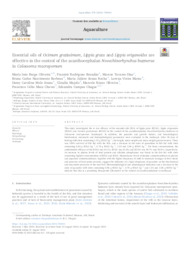Embrapa Amapá
 Busca de Publicações
Busca de Publicações
Essential oils of Ocimum gratissimum, Lippia grata and Lippia origanoides are effective in the control of the acanthocephalan Neoechinorhynchus buttnerae in Colossoma macropomum.
Autoria: OLIVEIRA, M. I. B.; BRANDÃO, F. R.; TAVARES-DIAS, M.; BARBOSA, B. C. N.; ROCHA, M. J. S.; MATOS, L. V.; SOUZA, D. C. M.; MAJOLO, C.; OLIVEIRA, M. R. de; CHAVES, F. C. M.; CHAGAS, E. C.
Resumo: This study investigated the in vivo efficacy of the essential oils (EOs) of Lippia grata (EOLG), Lippia origanoides (EOLO) and Ocimum gratissimum (EOOG) in the control of the acanthocephalan Neoechinorhynchus buttnerae in Colossoma macropomum (tambaqui). In addition, the parasitic and growth indices, and hematological, biochemical, enzymatic and histopathological parameters were evaluated in the tambaqui. After 30 days of feeding with diets containing 1.52 g EOLO kg−1, the length, mean weight and mean weight gain decreased. There was 100% survival of fish fed with the EOs, and a decrease in the rates of parasitism in fish fed with diets containing 0.86 g EOLG kg−1, 0.76 g EOLO kg−1, 1.03 and 2.06 g EOOG kg−1. For these concentrations, the anthelmintic efficacy of the EOLG was 62.1%, EOLO was 61.8% and EOOG was 58.7% and 59.8%, respectively. An increase in plasma levels of total protein and alkaline phosphatase was found in the fish fed with diets containing highest concentrations of EOLG and EOLO. Maintenance levels of alanine aminotransferase in plasma and aspartate aminotransferase, together with the higher frequency of mild to moderate damages in liver tissue and presence of focal point necrosis, suggest the influence of a high abundance of parasites on the biochemical and enzymatic processes of the host fish. Histomorphological and physiological indicators and a decrease in the rates of parasites with diets containing 0.86 g EOLG kg−1, 0.76 g EOLO kg−1 and 1.03 and 2.06 g EOOG kg−1 indicate that this is a promising therapeutic alternative in the control of acanthocephalosis in tambaqui.
Ano de publicação: 2024
Tipo de publicação: Artigo de periódico
Unidade: Embrapa Amapa
Palavras-chave: Efficacy, Eficácia, Fish farming, Fisiologia, Fisiologia Animal, Histopathology, Histopatologia, Peixe, Physiology, Piscicultura, Tambaqui

